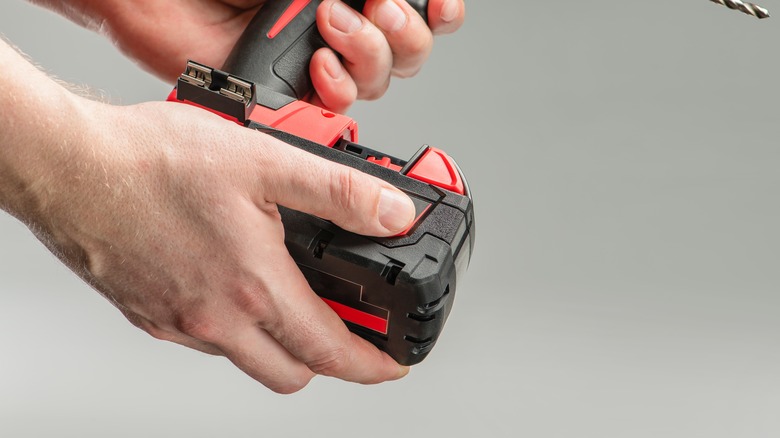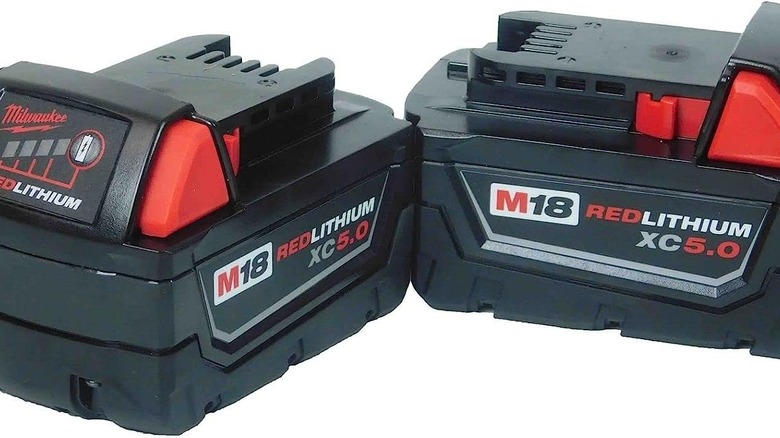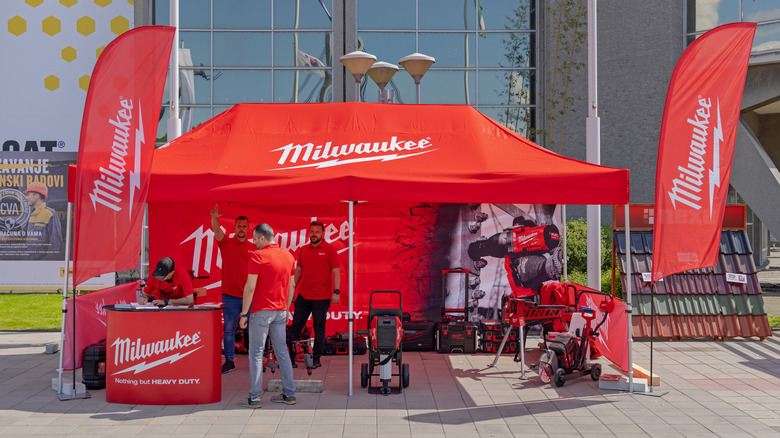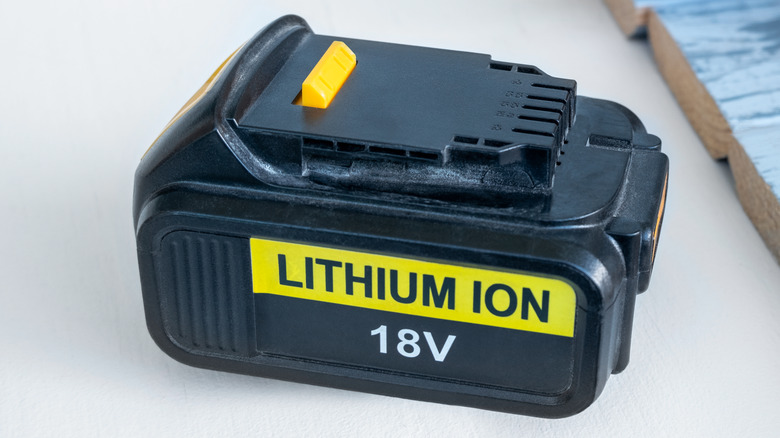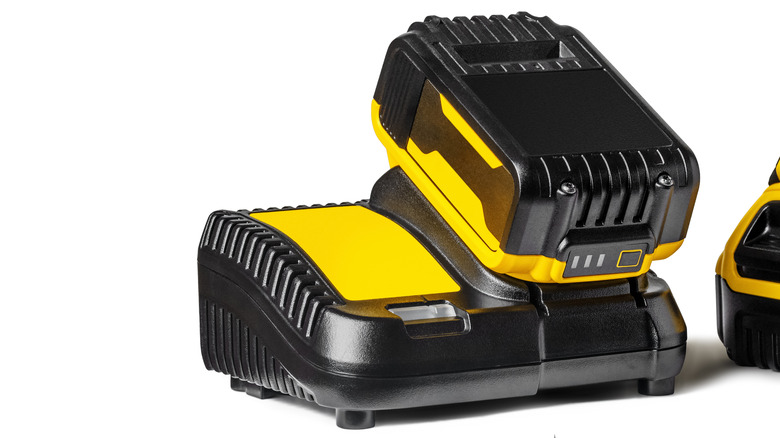The Reason Why Milwaukee Power Tool Batteries Are So Expensive
If you're a fan of cordless power tools, you may spot the occasional great deal. A drill, saw, or other tool from a brand like Milwaukee doesn't cost that much on its own. Its pricing is usually on par with, or sometimes cheaper, than the corded equivalent. Cordless tools are a lot more portable, versatile, and easier to use than corded tools, so if one is the same price it's a no-brainer, right?
As always, there's a catch with this kind of thing. That comes in the form of the battery packs the tools need to operate. If you see a tool for cheap, it's almost certainly a "batteries not included" type deal. The battery will have to be purchased separately and can cost as much, if not more, than the tool you've just splashed out on. Yes, there are off-brand batteries, and you can just buy one and switch it between compatible tools — but both of those methods have their downsides.
So as you bite the bullet and put at least one $150+ power pack into your cart, you may be wondering why it costs so much? Well, the answer is a little complicated and companies like Milwaukee are vague about their pricing strategies. But there are a few reasons why this seemingly simple component is one of the most expensive things in your tool bag.
The raw materials are expensive
The materials needed to make a lithium-ion battery are not cheap. It's part of the reason why electric vehicles are so expensive. Battery replacements for things like cell phones, laptops, and tablets tend to cost a pretty penny — and those are far smaller than the units powering your tools. There are many rare materials that go into a modern battery, but lithium and cobalt are two of the more expensive elements involved. Given the number of things that use batteries these days, along with a drive to increase the number of electric vehicles on the road, there's also a lot of competition for these materials.
Other costs include things like packaging and transport, batteries aren't the lightest things in the world. Not all power tool batteries are custom jobs either. However, good news may be on the horizon. Rare earth metal prices are currently dropping after spiking during the coronavirus pandemic. There's also a lot of promising research into things like solid state batteries, and other battery compositions, which should reduce the demand for these materials or in some cases negate the need for their use altogether. As a result, the price of power tool batteries may drop at some point in the future.
A lot of tech goes into Milwaukee's batteries
A lot more goes into Milwaukee's batteries than rare earth metals and a bit of charge. Some of the cells are actually jam-packed with tech that helps them function well, and continue to do so for a long time. Take the M18 REDLITHIUM XC5.0 for example, it isn't cheap at around $160, but it contains a number of cutting-edge features that set it apart from a basic battery.
Arguably the best of these features is "all-weather performance." When the weather gets particularly cold or hot, battery performance is reduced and this could create a situation where the pack can't power a tool properly. This feature mitigates that. Other features are handy too, for example, the charge gauge is a great way to ensure the battery has an optimal amount of juice in it, and REDLINK Intelligence seems to improve efficiency. Features like this require a lot of research, development, and testing — and that ultimately reflects in the final price.
The brand name comes at a premium
As with Nike and Levis in the fashion universe, brand names carry weight in the tool world too. Milwaukee, like DeWalt, Makita, and Bosch, has spent decades honing its reputation and can up the price for its official products as a result.
So while the sales pitch may revolve around the advanced tech, solid guarantees, performance, and reliability of things like batteries — you can rest assured that the label on the side of the product comes at a premium. With that said, this is not the overall cost and isn't something that should put you off. Milwaukee batteries are still packed with the aforementioned tech, made to stringent standards, and backed by a solid guarantee. There's no surefire way to buy the exact battery, or something close to it, sans branding for a discount. Worse yet, going off-brand can have other consequences that could leave you losing out in the long run.
Cheaper options have their own costs
If you spend a few minutes on eBay, you're likely to spot batteries that are both compatible with Milwaukee tools and are available at a fraction of the cost of their official equivalents. While these batteries can be a tempting buy, you should probably avoid them for a number of reasons. As the old adage goes, if a deal seems too good to be true, then it probably is.
Off-brand batteries may look the part, but there is likely a big difference beneath the shell. Something that might be immediately noticeable is power delivery. Cordless tool batteries are rated by voltage and designed to deliver certain amounts of power to the tool itself. A cheaper battery may not be able to deliver the power it claims to be capable of — which will be obvious when you attempt to do something more intense. If the power your tool needs to drill into hardwood or through a wall isn't there, the tool will underperform and may not be able to complete the task.
Beyond that, an off-brand battery may not hold as much charge as its rated for and is likely to go flat faster. It could also degrade after fewer recharge cycles than its official equivalent. So while an official battery is more expensive, you know exactly what you're getting and are unlikely to lose out in the long run.
Make sure you get the most out of your batteries
Given the large expense involved, it's probably a good idea to look after your tool's batteries as much as you possibly can. Unfortunately, if you're a tradesman, using a battery for multiple tools, or someone who engages in a lot of DIY, your battery may blast past its 1,000-cycle guarantee pretty quickly.
But there are other things you can do to preserve battery health and get the most out of what is an expensive piece of kit. As they're lithium-ion batteries, several things will affect their overall health. Two bigh things to look out for are temperature and charge levels. Letting a lithium battery go completely flat, or charging it to 100% isn't ideal. So keeping it charged between 10% and 80% should help minimize degradation.
Extreme heat or cold can also destroy the battery's cells. Sometimes you'll need to do a job somewhere hot or cold, so this can't always be avoided, plus the battery will generate some heat when in use or charging. But simply storing it at room temperature will really help maximize its lifespan. Don't store your battery in a shed or anywhere where temperatures could go below freezing. A hot van or somewhere similar will also cause damage to it.
